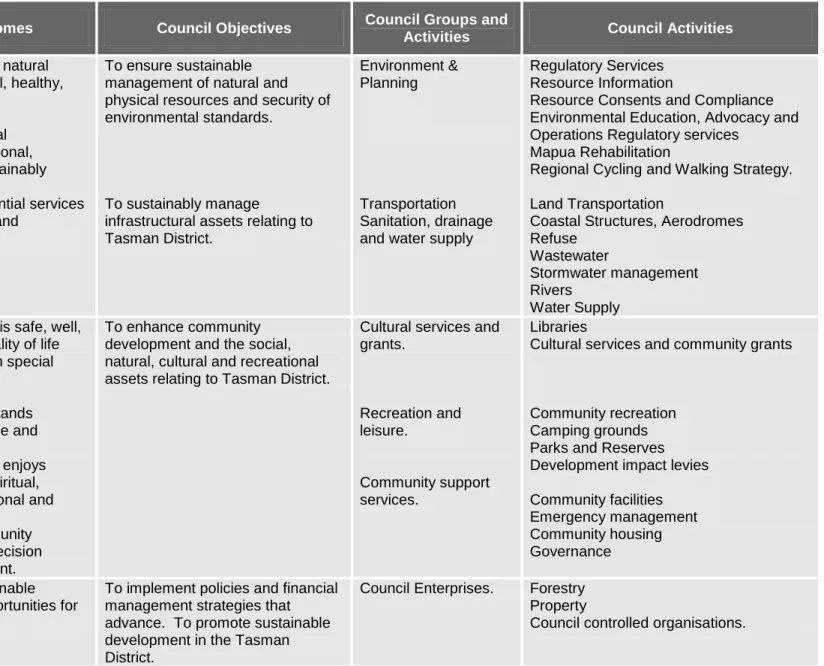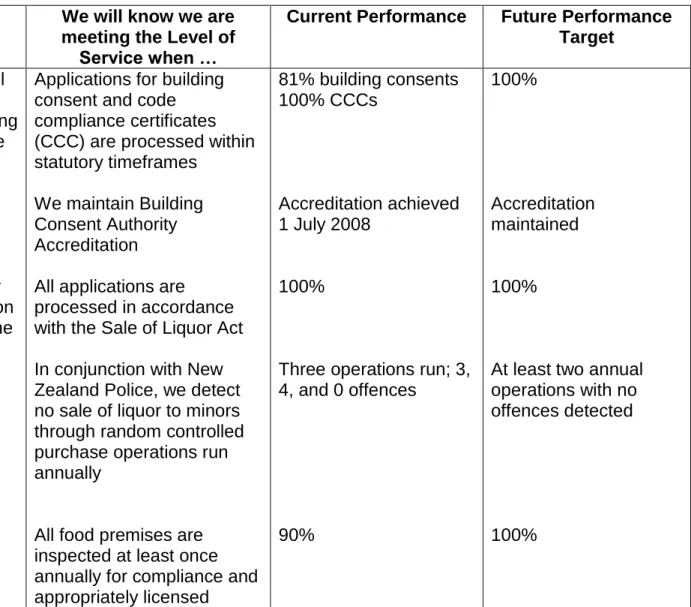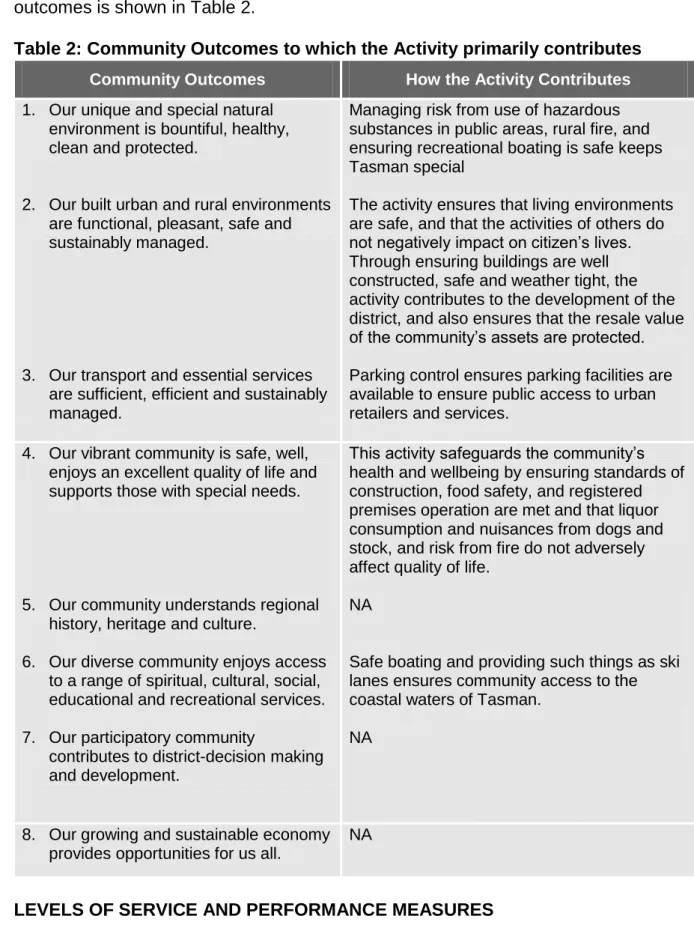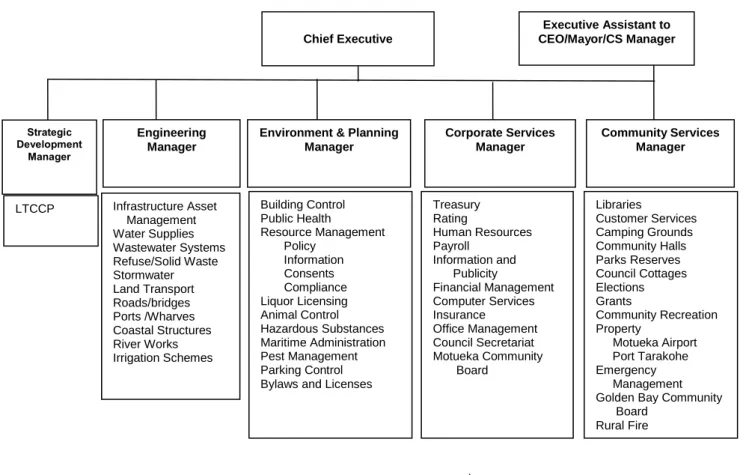INTRODUCTION
- The Regulatory Services Activity Management Plan: What is it and why is it produced?
- Rationale For The Council‟s Involvement in Regulatory Services
- Council‟s Principal Objectives
- Community Outcomes
As such, the activity contributes to the sustainable development of the district and the well-being of the community by ensuring that actions, or non-actions, taken by people in the Tasman District are legal, sustainable and safe. The Council carries out those responsibilities largely internally where the skills needed to do the work are available in the local community. The community has confidence in the service historically provided by the Council (and so the Council continues to provide the service).
The Council's stated vision is for "An interactive community living safely in the garden that is the Tasman District".

LEVELS OF SERVICE AND PERFORMANCE MEASURES
- Introduction
- Customer Research and Expectations
- The Activity Goal and Principal Objectives
- Future Planned Levels of Service and Performance Measures
Parking enforcement ensures that parking spaces are available to provide public access to city vendors and services. To inspect buildings, to ensure that buildings are constructed in a safe manner and that building inspection activities are carried out in a timely and professional manner. To control alcoholic beverages, ensure the responsible sale of alcoholic beverages in the district by timely and professional management of all applications.
For public health, to ensure that food offered for sale is safe, free from contamination and prepared in appropriate areas, that other public health risks are managed through appropriate permits for buildings and operations, and to occurrence and to reduce the spread and where possible to prevent communicable diseases. For Bylaw Administration, to ensure that statutes regulating activities are administered in a timely and competent manner with the aim of ensuring public health and safety. For Maritime Administration, to ensure that Tasman's harbor waters are safe and accessible and that all known commercial operators are registered.
For the management of hazardous substances, to ensure as far as possible, having regard to the Council's responsibilities, that risks from hazardous substances are minimized and managed appropriately. Process approval applications and undertake associated inspections in accordance with and to ensure compliance with various statutory requirements. We will provide building inspection services in a professional and timely manner to ensure the building work is safe and compliant with the New Zealand Building Code.
We will provide public health services to ensure that food offered for sale is safe, free from contamination and. We will develop and administer appropriate regulations designed to ensure that certain activities are administered in a timely and competent manner for the purpose of protecting public health and safety. We will provide Maritime administration services to ensure that Tasman's harbor waters are safe and accessible and that all known commercial operators are registered.
An annual summary will be provided as part of the Annual Report and trends are monitored when this activity management plan is reviewed.

EXISTING SITUATION DESCRIBED
- Building Control
- Liquor Licensing
- Public Health
- Bylaw Administration
- Maritime Administration
- Hazardous Substances Management
- Animal Control
- Parking Control
- Rural Fire
- Maintenance and Operating
- Operating and Resource Issues
- Business Continuity / Emergency Management
Workload to date has precluded an audit of the building warrant for fitness requirements, but systems will be put in place to address this. The operation of this activity is relatively large in terms of staff numbers and budget considerations, and is decisive in terms of the contribution it makes to the sustainable development of the District. In addition to the number of building consent applications processed, this activity is also governed by legislation regarding the time it can take to process applications.
In New Zealand, the sale of alcohol is governed by the Sale of Liquor Act 1989, plus amendments to the Act in 1997 and 1999. In relation to the latter and to the extent we can, the Council relies on general powers under the RMA. The Council is also legally responsible for the control of activities within port boundaries as defined in our Navigation and Safety Bylaw.
The council is also responsible for administering seizure laws to ensure control of the traveling stock. The council is also responsible for the removal of derelict vehicles under the Local Government Act 1974. As a stakeholder in the joint operation, the Council appoints a representative to the WRFA and also contributes operational resources to manage and deliver rural fire services.
The council is also responsible for the provision of fire extinguishers, fire equipment and supplies under the operating agreement. In the event of a natural disaster, most businesses would cease to operate in their current mode as staff would be involved in responding to the event, e.g. building inspectors and health inspectors who would ensure public health and safety.
FUTURE ISSUES
Factors Affecting Delivery and Demand for Activity
- TRENDS IN COMMUNITY EXPECTATIONS
The Council has identified a key area of risk as the threat of disruption to services due to the loss of significant numbers of staff over a long period of time. Council's Business Interruption Insurance covers "loss due to interruption of the business due to damage to property insured by the Material Damage policy, resulting in losses or increased costs...". The Board has a daily backup-to-tape schedule in place for all information stored on the computer system and a mirror system updated at 10 minute intervals is located off-site at the Richmond Library.
Hard copies of all applications and reports are kept within the Record System which is fireproof. The Council has Policies on Dangerous Buildings and Dangerous Dams to address earthquake risk as required under the Building Act 2004. At one extreme calls for more better regulation and enforcement and at the other for less intervention and.
Changes in community expectations over time may lead to increases or decreases in service levels. Technological changes may affect the scope of services and the method of implementation, but there are no foreseen technological changes that would have a significant impact on the activity in the medium term. By 2010, the Council must introduce a quality assurance program for its building control systems which will be subject to accreditation.
RENEWALS CAPITAL EXPENDITURE AND DEPRECIATION
FUTURE PROGRAMME
FUNDING THE ANNUAL NET COST
Funding Issues
The Council considers that the administration of the Purchase Act is solely to the benefit of the individual and user groups. The Council believes that while the primary beneficiaries of the provision of public health services are the individual or user groups, this activity provides protection for society as a whole. It has therefore decided that the funding of the public health activity will be in the form of fees and charges to those applying for health permits for food and other premises, together with a contribution from the rates to finance the activities that cannot be recovered from a individual.
The Council considers that the main beneficiaries of the administration of the Trading in Public Places Act are the individuals who obtain a licence, but that this activity provides protection for the community as a whole, and other commercial operators are indirect beneficiaries. He therefore stipulated that funding for the activities of the by-laws administration would be through fees and charges for those applying for mobile shop permits and hawker permits. Council believes that the position of Harbor Master benefits the community as a whole by promoting safe sailing and boating.
The Council believes that the community as a whole benefits by reducing the risk of the use of hazardous substances in public places, which is the main focus of the Council's efforts. The main beneficiary of animal control provision is the individual, but it is also recognized that the community as a whole is also a significant beneficiary. The Council determined that the funding of dog control should be by way of fees to those who register dogs and recoveries from offending owners.
The council appreciates that this activity is undertaken to benefit the general public in general in avoiding the consequences of uncontrolled fires. It is therefore a public cost, although some subsidy assistance is provided by the National Rural Fire Authority and recoveries may be achieved in certain circumstances by those who cause fires.
Schedule of Fees and Charges
Some recovery could be achieved by concluding a contract with the Ministry of Labor if the council intended to take over the monitoring of jobs, but no decision has been made on this. Stock control will be funded through recoveries where possible and uncovered costs will be funded from general tariffs. The Council considers that this activity is carried out to ensure that individuals comply with parking regulations; therefore, it should be funded by those individuals who violate regulations and by-laws by using fines and penalties.
The removal of abandoned vehicles is funded by the general rate – while recoveries from owners are desirable, it is mostly not possible or practical to find those responsible.
SIGNIFICANT NEGATIVE EFFECTS
SIGNIFICANT FORECASTING ASSUMPTIONS, UNCERTAINTIES, AND RISK
Assumptions and Uncertainties
Risk Management
PLAN REVIEW
CONCLUSION
AN OVERVIEW OF THE COUNCIL’S ORGANISATIONAL STRUCTURE
Organisational Structure
Management Practices, Data Systems and Decision-Making Processes
- ACCOUNTING / FINANCIAL SYSTEMS
- INFORMATION MANAGEMENT SYSTEMS
- GEOGRAPHICAL INFORMATION SYSTEM
- DELEGATIONS AND APPOINTMENT REGISTER
STAKEHOLDERS AND CONSULTATION
Consultation
Stakeholders
RURAL FIRE ASSETS AND EQUIPMENT
Activity An activity means the good or service provided by the Council to achieve a desired outcome. Activity management plans are key strategic documents that describe all aspects of managing an activity. The documents feed information directly into the Council's LTCCP, and place an emphasis on long-term financial planning, community consultation and a clear definition of service levels and performance standards.
Annual Plan The Annual Plan provides a statement of the direction of the Council and ensures consistency and co-ordination in both the making of policies and decisions regarding the use of the Council's resources. It is a reference document for monitoring and measuring performance for the community as well as the Council itself. The Long Term Council Community Plan (LTCCP) is the primary strategic document through which the Council communicates its intentions over the next 10 years to meet community service expectations and how it intends to fund this work.
A qualitative or quantitative measurement of a service or activity that is used to compare actual performance against another standard or target. Performance indicators are usually related to legal limits, safety, responsiveness, cost, convenience, asset performance, reliability, efficiency, environmental protection and customer satisfaction. Continuous or periodic quantitative and qualitative assessments of actual performance compared to specific goals, objectives, or standards.

